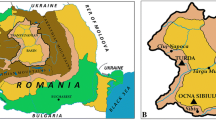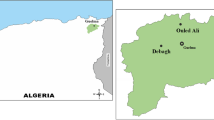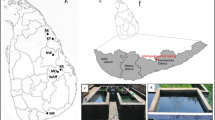Abstract
Prokaryotes in the superficial sediments are ecologically important microorganisms that are responsible for the decomposition, mineralization and subsequent recycling of organic matter. The aim of this study was to explore the phylogenetic and functional diversity of halophilic archaea and bacteria isolated from the superficial sediments of solar salterns at Sfax, Tunisia. Sixty four strains were isolated from crystallizer (TS18) and non-crystallizer (M1) ponds and submitted to genotypic characterization and evaluation by amplified ribosomal RNA restriction analysis (ARDRA) techniques. Our findings revealed that the archaeal diversity observed for 29 isolates generated five distinct patterns from the non-crystallizer M1 pond, with Halorubrum chaoviator as the most prevalent cultivable species. However, in the TS18 crystallizer pond, ten restriction patterns were observed, with the prevalence of haloarchaea EB27K, a not yet identified genotype. The construction of a neighbour-joining tree of 16S rRNA gene sequences resulted in the division of the potential new species into two major groups, with four strains closely related to the sequence of the unculturable haloarchaeon EB27K and one strain to the recently described Halovenus aranensis strain. The 35 bacterial strains observed in this work were present only in the non-crystallizer pond (M1) and presented two distinct ARDRA patterns. These strains belonged to the γ-proteobacteria subdivision, with members of Salicola marasensis (83 %) being the most predominant species among the isolates. 16S rRNA gene sequencing revealed that Salicola strains displayed different degrees of homogeneity. The results from pulsed field gel electrophoresis assays showed that the Salicola isolates could be clustered in two distinct groups with different genome sizes.





Similar content being viewed by others
References
Altschul SF, Gish W, Miller W, Myers EW, Lipman DJ (1990) Basic local alignment search tool. J Mol Biol 215:403–410
Amoozegar MA, Malekzadeh F, Malik KA (2003) Production of amylase by newly isolated moderate halophile, Halobacillus sp. Strain MA-2. J Microbiol Methods 52:353–359
Antón J, Oren A, Benlloch S, Rodríguez-Valera F, Amann R, Rosselló-Mora R (2002) Salinibacter ruber gen. nov., sp. nov., a novel, extremely halophilic member of the bacteria from saltern crystallizer ponds. Int J Syst Evol Microbiol 52:485–491
Antón J, Peña A, Valens M, Santos F, Glöckner F-O, Bauer M, Dopazo J, Herrero J, Roselló-Mora R, Amann R (2005) Salinibacter ruber: genomics and biogeography. In: Gunde-Cimerman N, Oren A, Plemenitas A (eds) Adaptation to life at high salt concentrations in archaea, bacteria, and eukarya. Springer, Dordrecht, pp 253–266
Antón J, Peña A, Santos F, Martínez-García M, Schmitt-Kopplin P, Rossello´-Mora R (2008) Distribution, abundance and diversity of the extremely halophilic bacterium Salinibacter ruber. Saline Syst 4:2
Ayadi H, Toumi N, Abid O, Medhioub K, Hammami M, Sime-Ngando T, Amblard C, Sargos D (2002) Etude qualitative et quantitative des peuplements phytoplanctoniques et zooplanctoniques dans les bassins de la saline de Sfax, Tunisie. Rev Sci Eau 15:123–135
Baati H, Guermazi S, Amdouni R, Gharsallah N, Sghir A, Ammar E (2008) Prokaryotic diversity of a Tunisian multipond solar saltern. Extremophiles 12:505–518
Baati H, Guermazi S, Gharsallah N, Sghir A, Ammar E (2009) Microbial community of salt crystals processed from Mediterranean seawater based on 16S rRNA analysis. Can J Microbiol 56:44–51
Baati H, Amdouni R, Gharsallah N, Sghir A, Ammar E (2010a) Isolation and characterization of moderately halophilic bacteria from Tunisian solar saltern. Curr Microbiol 60:157–161
Baati H, Guermazi S, Gharsallah N, Sghir A, Ammar E (2010b) Novel prokaryotic diversity in sediments of Tunisian multipond solar saltern. Res Microbiol 161:573–582
Benlloch S, Acinas SG, Antón J, López-López A, Luz SP, Rodríguez-Valera F (2001) Archaeal biodiversity in crystallizer ponds from a solar saltern: culture versus PCR. Microbiol Ecol 41:12–19
Berrada I, Willems A, De Vos P, El Fahime EM, Swings J, Bendaou N, Melloul M, Amar M (2012) Diversity of culturable moderately halophilic and halotolerant bacteria in a marsh and two salterns a protected ecosystem of Lower Loukkos (Morocco). Afr J Microbiol Res 6:2419–2434
Bhatnagar T, Boutaiba S, Hacene H, Cayol JL, Fardeau ML, Ollivier B, Baratti JC (2005) Lipolytic activity from Halobacteria: screening and hydrolase production. FEMS Microbiol Lett 248:133–140
Bianchi M, Marty D, Caumette P, Bertrand JC, Gauthier M (1989) Micro organismes dans les écosystèmes océaniques. Masson, Paris
Birbir M, Kalli N, Johansson C (2002) The examination of salt quality of Sereflikochisar lake used in Turkish leather industry. J Soc Leather Technol Chem 86:112–117
Birbir M, Ogan A, Calli B, Mertoglu B (2004) Enzyme characteristics of extremely halophilic archaeal community in Tuzkoy Salt Mine, Turkey. Word J Microb Biotechnol 20:613–621
Boujelben I, Gomariz M, Martínez-García M, Santos F, Peña A, López C, Antón J, Maalej S (2012a) Spatial and seasonal prokaryotic community dynamics in ponds of increasing salinity of Sfax solar saltern in Tunisia. Antonie Leeuwenhoek 101:845–857
Boujelben I, Yarza P, Almansa C, Villamor J, Maalej S, Antón J, Santos F (2012b) Virioplankton community in Tunisian solar saltern. Appl Environ Microbiol. doi:10.1128/AEM.01793-12
Bowers KJ, Wiegel J (2011) Temperature and pH optima of extremely halophilic archaea: a mini-review. Extremophiles 15:119–128
Burns DG, Camakaris HM, Janssen PH, Dyall-Smith ML (2004) Combined use of cultivation-dependent and cultivation-independent methods indicates that members of most haloarchaeal groups in an Australian crystallizer pond are cultivable. Appl Environ Microbiol 70:5258–5265
Burns DG, Janssen PH, Itoh T, Kamekura M, Li Z, Jensen G, Rodriguez-Valera F, Bolhuis H, Dyall-Smith ML (2007) Haloquadratum walsbyigen. nov., sp.nov., the square haloarchaeon of Walsby, isolated from saltern crystallizers in Australia and Spain. Int J Syst Evol Microbiol 57:387–392
Caraux G, Pinloche S (2005) PermutMatrix: a graphical environment to arrange gene expression profiles in optimal linear order. Bioinformatics 21:1280–1281
Caton TM, Witte LR, Ngyuen HD, Buchheim JA, Buchheim MA, Schneegurt MA (2004) Halotolerant aerobic heterotrophic bacteria from the great salt plains of Oklahoma. Microb Ecol 48:449–462
Chaiyanan S, Chaiyanan S, Maugel T, Huq A, Robb FT, Colwell RR (1999) Polyphasic taxonomy of a novel Halobacillus, Halobacillus thailandensis sp. nov. isolated from fish sauce. Syst Appl Microbiol 22:360–365
Ćirić S, Petrović O, Milenković D (2010) Low nutriment R2A medium in monitoring microbiological quality of drinking water. Chem Ind Chem Eng Q 16:39–45
Cuadros-Orellana S, Martin-Cuadrado AB, Legault B, D’Auria G, Zhaxybayeva O, Papke RT, Rodríguez-Valera F (2007) Genomic plasticity in prokaryotes: the case of the square haloarchaeon. ISME J 1:235–245
DasSarma S, Fleischmann EM, Rodriguez-Valera F (1995) Appendix 2. Media for halophiles. In: Robb FT (ed) Archaea: a laboratory manual, Cold Spring Harbor Laboratory Press, New York, pp 225–230
DeLong EF (1992) Archaea in coastal marine environments. Proc Natl Acad Sci USA 89:5685–5689
Divya B, Soumya KV, Nair S (2010) 16S rRNA and enzymatic diversity of culturable bacteria from the sediments of oxygen minimum zone in the Arabian Sea. Antonie Leeuwenhoek 98:9–18
Dong H, Zhang G, Jiang H, Yu B, Chapman LR, Lucas CR, Fields MW (2006) Microbial diversity in sediments of saline Qinghai Lake, China: linking geochemical controls to microbial diversity. Microbiol Ecol 51:65–82
Dyall-Smith ML, Burns DG, Camakaris HM, Janssen PH, Russ BE, Porter K (2005) Haloviruses and their hosts. In: Gunde-Cimerman N, Oren A, Plemenitas A (eds) Adaptation to life at high salt concentrations in archaea, bacteria, and eukarya. Springer, Dordrecht, pp 553–564
Elloumi J, Carrias J-F, Ayadi H, Sime-Ngando T, Boukhris M, Bouain A (2006) Composition and distribution of planktonic ciliates from ponds of different salinity in the solar saltwork of Sfax, Tunisia. Estuar Coast Shelf Sci 67:21–29
Elloumi J, Guermazi W, Ayadi H, Bouain A, Aleya L, Aleya L (2008) Detection of water and sediments pollution of an arid saltern (Sfax, Tunisia) by coupling the distribution of microorganisms with hydrocarbons. Water Air Soil Pollut 187:157–171
Elloumi J, Guermazi W, Ayadi H, Bouain A, Aleya L (2009) Abundance and biomass of prokaryotic and eukaryotic microorganisms coupled with environmental factors in an arid multi-pond solar saltern (Sfax, Tunisia). J Mar Biol Assoc UK 89:243–253
Hedi A, Sadfi N, Fardeau ML, Rebib H, Cayol JL, Ollivier B, Boudabous A (2009) Studies on the biodiversity of halophilic microorganisms isolated from El-Djerid salt lake (Tunisia) under aerobic conditions. Int J Microbiol. doi:10.1155/2009/731786
Imadalou-Idres N, Carre-Mlouka A, Vandervennet M, Yahiaoui H, Peduzzi J, Rebuffat S (2013) Diversity and antimicrobial activity of cultivable halophilicarchaea from three Algerian sites. J Life Sci (Libertyville) 7:1057–1069
Jensen S, Bergh O, Enger O, Hjeltnes B (2002) Use of PCR-RFLP for genotyping 16S rRNA and characterizing bacteria cultured from halibut fry. Can J Microbiol 48:379–386
Jiang H, Dong H, Zhang G, Yu B, Chapman LR, Fields MW (2006) Microbial diversity in water and sediment of Lake Chaka, an athalassohaline lake in Northwestern China. Appl Environ Microbiol 72:3832–3845
Kharroub K, Aguilera M, Quesada T, Morillo JA, Ramos-Cormenzana A, Boulharouf A, Monteoliva-Sanchez M (2006) Salicola salis sp. nov., an extremely halophilic bacterium isolated from Ezzemoul sabkha in Algeria. Int J Syst Evol Microbiol 56:2647–2652
Lane DJ (1991) 16S/23S rRNA sequencing. In: Stackebrandt E, Goodfellow M (eds) Nucleic acid techniques in bacterial systematics. Wiley, New York, pp 115–175
Litchfield CD, Gillevet PM (2002) Microbial diversity and complexity in hypersaline environments: a preliminary assessment. J Ind Microbiol Biotechnol 28:48–55
Lungmann P, Choorit W, Prasertsan P (2007) Physio-chemical and biological properties of partially purified exopolymers from newly isolated halophilic bacterial strain SM5. Songklanakarin J Sci Technol 29:1571–1582
Makhdoumi Kakhki A, Amoozegar MA, Mahmodi Khaledi E (2011) Diversity of hydrolytic enzymes in haloarchaeal strains isolated from salt lake. Int J Environ Sci Technol 8:705–714
Makhdoumi-Kakhki A, Amoozegar MA, Ventosa A (2012) Halovenus aranensis gen. nov., sp. nov., an extremely halophilic archaeon from Aran-Bidgol salt lake. Int J Syst Evol Microbiol 62:1331–1336
Mancinelli RL, Landheim R, Sanchez-Porro C, Dornmayr-Pfaffenhuemer M, Gruber C, Legat A, Ventosa A, Radax C, Ihara K, White MR, Stan-Lotter H (2009) Halorubrum chaoviator sp. nov., a haloarchaeon isolated from sea salt in Baja California, Mexico, Western Australia and Naxos, Greece. Int J Syst Evol Microbiol 59:1908–1913
Mani K, Salgaonkar BB, Das D, Braganca JM (2012a) Community solar salt production in Goa, India. Aquat Biosyst 8:30
Mani K, Salgaonkar BB, Braganca JM (2012b) Culturable halophilic archaea at the initial and crystallization stages of salt production in a natural solar saltern of Goa, India. Aquat Biosyst 8:15
Martinez-Murcia AJ, Acinas SG, Rodriguez-Valera F (1995) Evaluation of prokaryotic diversity by restrictase digestion of 16S rDNA directly amplified from hypersaline environments. FEMS Microbiol Ecol 17:247–256
Maturrano L, Santos F, Rosselló-Mora R, Antón J (2006a) Microbial diversity in Maras salterns, a hypersaline environment in the Peruvian Andes. Appl Environ Microbiol 72:3887–3895
Maturrano L, Valens-Vadell M, Rosselló-Mora R, Antón J (2006b) Salicola marasensis gen. nov., sp. nov., an extremely halophilic bacterium isolated from the Maras solar salterns in Peru. Int J Syst Evol Microbiol 56:1685–1691
Moreno Mde L, García MT, Ventosa A, Iglesias-Guerra F, Mellado E (2010) The extremely halophilic bacterium Salicola marasensis IC10 accumulates the compatible solute betaine. Syst Appl Microbiol 33:308–310
O’Sullivan DJ (2000) Methods for analysis of the intestinal microflora. Curr Issues Intest Microbiol 1:39–50
Oren A (1995) The role of glycerol in the nutrition of halophilic archaeal communites: a study of respiratory electron transport. FEMS Microbiol Ecol 16:281–290
Oren A (2006) Life at high salt concentrations. In: Dworkin M, Falkow S, Rosenberg E, Schleifer KH, Stackebrandt E (eds) The prokaryotes a handbook on the biology of bacteria: ecophysiology and biochemistry. Springer, New York, pp 263–282
Oren A (2010) Industrial and environmental applications of halophilic microorganisms. Environ Technol 31:825–834
Oren A, Ventosa A, Grant WD (1997) Proposed minimal standards for description of new taxa in the order halobacteriales. Int J Syst Bacteriol 47:233–238
Oren A, Rodríguez-Valera F, Antón J, Benlloch S, Rosselló-Mora R, Amann R, Coleman J, Russell NJ (2004) Red, extremely halophilic, but not archaeal: the physiology and ecology of Salinibacter ruber, a bacterium isolated from saltern crystallizer ponds. In: Ventosa A (ed) Halophilic microorganisms. Springer-Verlag, Berlin, pp 63–76
Pašić L, Ulrih NP, Crnigoj M, Grabnar M, Velikonja BH (2007) Haloarchaeal communities in the crystallizers of two adriatic solar salterns. Can J Microbiol 53:8–18
Pedrós-Alió C (2004) Trophic ecology of solar salterns. In: Ventosa A (ed) Halophilic microrganisms. Springer-Verlag, Berlin, pp 33–48
Pedrós-Alió C, Calderón-Paz JI, MacLean MH, Medina G, Marrasé C, Gasol JM, Guixa-Boixereu N (2000) The microbial food web along salinity gradients. FEMS Microbiol Ecol 32:143–155
Peña A, Valens M, Santos F, Buczolits S, Antón J, Kämpfer P, Busse HJ, Amann R, Rosselló-Mora R (2005) Intraspecific comparative analysis of the species Salinibacter ruber. Extremophiles 9:151–161
Porter KG, Feig YS (1980) The use of DAPI for identifying and counting aquatic microflora. Limnol Oceanogr 25:943–948
Reasoner DJ, Gelderich EE (1985) A new medium for the enumeration and subculture of bacteria from potable water. Appl Environ Microbiol 49:1–7
Rohban R, Amoozegar MA, Ventosa A (2009) Screening and isolation of halophilic bacteria producing extracellular hydrolyses from Howz Soltan Lake, Iran. J Ind Microbiol Biotechnol 36:333–340
Sabet S, Diallo L, Hays L, Jung W, Dillon JG (2009) Characterization of halophiles isolated from solar salterns in Baja California, Mexico. Extremophiles. doi:10.1007/s00792-009-0247-1
Sass AM, McKew BA, Sass H, Fichtel J, Timmis KN, McGenity TJ (2008) Diversity of Bacillus-like organisms isolated from deep-sea hypersaline anoxic sediments. Saline Syst 4:8. doi:10.1186/1746-1448-4-8
Tamura K, Dudley J, Nei M, Kumar S (2007) MEGA4: molecular evolutionary genetics analysis (MEGA) software version 4.0. Mol Biol Evol 24:1596–1599
Tang SK, Wang Y, Lou K, Mao PH, Jin X, Jiang CL, Xu LH, Li WJ (2009) Gracilibacillus saliphilus sp. nov., a moderately halophilic bacterium isolated from a salt lake. Int J Syst Evol Microbiol 59:1620–1624
Trigui H, Masmoudi S, Brochier-Armanet C, Barani A, Grégori G, Denis M, Dukan S, Maalej S (2011a) Characterization of heterotrophic prokaryote subgroups in the Sfax coastal solar salterns by combining flow cytometry cell sorting and phylogenetic analysis. Extremophiles 15:347–358
Trigui H, Masmoudi S, Brochier-Armanet C, Maalej S, Dukan S (2011b) Characterization of Halorubrum Sfaxensesp. nov., a new halophilic archaeon isolated from the solar saltern of Sfax in Tunisia. Int J Microbiol. doi:10.1155/2011/240191
Trigui H, Masmoudi S, Brochier-Armanet C, Maalej S, Dukan S (2011c) Survival of extremely and moderately halophilic isolates of Tunisian solar salterns after UV-B or oxidative stress. Can J Microbiol 57:923–933
Ventosa A (2006) Unusual micro-organisms from unusual habitats: hypersaline environments. In: Logan NA, Lappin Scott HM, Oyston PCF (eds) Prokaryotic diversity: mechanism and significance. Cambridge University Press, Cambridge, pp 223–253
Walsby AE (2005) Archaea with square cells. Trends Microbiol 13:193–195
Yamamoto N, Lopez G (1985) Bacterial abundance in relation to surface area and organic content of marine sediments. J Exp Mar Biol Ecol 90:209–220
Yeon SH, Jeong WJ, Park JS (2005) The diversity of culturable organotrophic bacteria from local solar salterns. J Microbiol 43:1–10
Zimmermann R, Iturriaga R, Becker-Birck J (1978) Simultaneous determination of the total number of aquatic bacteria and the number thereof involved in respiration. Appl Environ Microbiol 36:926–935
Acknowledgments
The authors would like to express their sincere gratitude to Mr. Anouar Smaoui and Mrs. Hanen Ben Salem from the English language unit at the Sfax Faculty of Science, Tunisia, for their valuable language editing and polishing services.
Author information
Authors and Affiliations
Corresponding author
Rights and permissions
About this article
Cite this article
Boujelben, I., Martínez-García, M., van Pelt, J. et al. Diversity of cultivable halophilic archaea and bacteria from superficial hypersaline sediments of Tunisian solar salterns. Antonie van Leeuwenhoek 106, 675–692 (2014). https://doi.org/10.1007/s10482-014-0238-9
Received:
Accepted:
Published:
Issue Date:
DOI: https://doi.org/10.1007/s10482-014-0238-9




